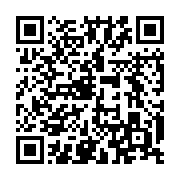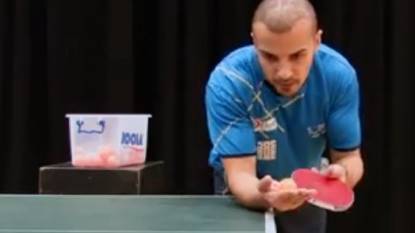How To Master A Legal Table Tennis Serve: The Definitive Guide
By: Mark
August 24, 2015 | Updated: October 22, 2025
Picture of Eli Baraty by Mark Kemp
Hey there, fellow table tennis player! You probably already know that a legal table tennis serve is a critical part of the game that every player must master. It’s not just about following the rules and avoiding losing points due to rule violations, but also about gaining an advantage over your opponent and setting the tone for the rest of the match.
A well-executed serve can make all the difference in a game, forcing your opponent to return a difficult shot or setting up an opportunity for you to attack. It can also establish your dominance and confidence, putting your opponent on the back foot right from the start.
So, what are the critical elements of a legal table tennis serve? The International Table Tennis Federation (ITTF) has strict guidelines and rules that govern legal table tennis serves, and following them is essential. Holding the ball stationary above the playing surface, tossing the ball up at least six inches, making contact with the ball after it has bounced once on your side of the table, and ensuring that the ball bounces on the opponent’s side after contact are all essential elements of a legal serve. You must also not touch the table with your free hand or any part of your body, nor hide the ball from your opponent during the serve.
Now, here’s the fun part - improving your serve to gain an edge over your opponents! Consistency is crucial to ensure that your serves are repeatable and accurate, while experimenting with spin can make your serves more challenging for your opponent to return. Timing is also critical in executing a successful serve, and practicing your timing by hitting the ball at different heights and speeds can help you improve this aspect. Finally, analyzing and improving your technique through the use of video analysis or mirror feedback can help you identify areas of improvement and increase your success rate.
In conclusion, mastering the legal table tennis serve is not just about following the rules, but also about gaining an edge over your opponents and becoming a more successful player. So, practice, experiment, and analyze your technique to take your game to the next level!
The Rules of a Legal Table Tennis Serve
The International Table Tennis Federation (ITTF) has strict rules governing the legal serve in table tennis. The serve must follow specific guidelines to be considered legal, and failure to comply can result in the loss of a point. The following are the key rules governing a legal table tennis serve:
- The ball must be placed in the palm of the hand.
- The ball must be held stationary above the playing surface.
- The ball must be tossed up at least six inches.
- The ball must be struck so that it first bounces on the server’s side of the table and then on the opponent’s side.
- The ball must not be hidden from the opponent during the serve.
- The server must not touch the table with their free hand or any part of their body.
- The serve must be delivered from behind the end line of the table.
The Components of a Legal Table Tennis Serve
A legal table tennis serve comprises three key components: the toss, the contact, and the follow-through. Each of these components is essential for a successful serve.
The Toss
The toss is the starting point of the serve, and it must be executed correctly to set up the rest of the serve. The toss must be at least six inches high and allow the server to contact the ball at the highest point possible. The server should aim for consistency in their toss to increase their chances of executing a successful serve.
The Contact
The contact is the moment when the server strikes the ball with their racket. The server must make contact with the ball after it has bounced once on their side of the table and before it bounces on the opponent’s side. The contact must be made with the racket above the table level and behind the end line of the table.
The Follow-Through
The follow-through is the final component of the serve, and it involves the server’s movement after making contact with the ball. A proper follow-through involves moving the racket towards the opponent’s side of the table and maintaining a consistent movement to prevent telegraphing the direction of the ball.
How to Improve Your Table Tennis Serve
Improving your table tennis serve takes practice, patience, and dedication. The following tips can help you improve your serve and gain an edge over your opponents:
- Focus on Consistency
Consistency is key to a successful serve. Aim to keep your toss consistent and repeatable, as this will help you hit the ball at the highest point possible and improve your accuracy. - Experiment with Spin
Adding spin to your serve can make it more challenging for your opponent to return. Experiment with different types of spin, such as topspin or backspin, to keep your opponent guessing. - Practice Your Timing
Timing is critical in executing a successful serve. Practice your timing by hitting the ball at different heights and speeds, and pay attention to your contact
How To Practice Serving on Your Own
Practicing table tennis serves on your own can be challenging, but with the help of a table in playback mode, it can be easier and more effective. In this article, we will discuss the benefits of practicing serves on your own, how to set up a table in playback mode, and some tips for improving your serve.
Benefits of Practicing Table Tennis Serves on Your Own
- Practicing table tennis serves on your own can have several benefits, including:
- Consistency - Practicing serves on your own allows you to work on your consistency without the distraction of a partner.
- Repetition - Repeating serves on your own can help you develop muscle memory and improve your accuracy.
- Time Management - Practicing on your own allows you to manage your time effectively without relying on a partner’s schedule.
Setting Up a Table in Playback Mode
To practice table tennis serves on your own with a table in playback mode, follow these simple steps:
- Adjust the net to the correct height and tension.
- Adjust the angle of the table to the playback position. The playback position allows the ball to be returned to you automatically, allowing for continuous practice.
- Set the playback mode to the desired speed and frequency. You can adjust the speed and frequency according to your skill level and goals.
- Start practicing your serves!
Tips for Improving Your Serve
Here are some tips for improving your serve while practicing on your own with a table in playback mode:
- Experiment with Spin - Practicing different types of spin, such as topspin or backspin, can help you add variety to your serves and keep your opponent guessing.
- Focus on Consistency - Consistency is key to a successful serve. Aim to keep your toss consistent and repeatable, as this will help you hit the ball at the highest point possible and improve your accuracy.
- Practice Your Timing - Timing is critical in executing a successful serve. Practice your timing by hitting the ball at different heights and speeds, and pay attention to your contact point.
- Analyze Your Technique - Use a video camera or mirror to analyze your technique and make adjustments as necessary. This will help you identify areas of improvement and increase your overall success rate.
In conclusion, practicing table tennis serves on your own with a table in playback mode can be an effective way to improve your consistency, repetition, and time management. By following these simple steps and tips, you can take your serve to the next level and gain an advantage over your opponents.
What Are Some Basic Table Tennis Serves?
I get this question asked a lot from players that are just starting out and want to get to grips with the basics, so they can progress with their game. Very often, people form bad habits from the start.
It’s essential that you start to learn a few basic serves to give yourself more fun with the game and become a better player, whether you play on an indoor table tennis table ot prefer to play on an outdoor ping pong table.
There are loads of options when it comes to serves and you might what to watch some of the professional table tennis players like the USA Team do their serves on youtube and basically copy them until you perfected your table tennis serve.
Here, we detail three basic serves so you can learn to use them at home on your ping pong table. These basic serves will lead into using more advanced serves. Let us help you form good habits to enhance your overall playing experience. Study the masters, practise constantly, be patient and one day soon you will become a master!
A good player should always have at least 10 different serve in his tool bag to use at any one time. This gives you a competitive edge and will always keep your opponent guessing because they don’t know what to expect or what serve is coming next, that’s what keeps them on their toes and makes you a great player.
Today I'm going to give you 3 examples of basic serves that you can practise. Forehand topspin long serve Backhand chop short serve Backhand topspin serve, but first a few tips:
- I worked out a very long time ago: a good serve is a lot to do with how you stand, position your body and follow through with the ball when throwing the ball up in the air and striking the ball. Positioning your body, so you can pivot round and be in a ready position when the return of serve comes at you
- You should always have a flat open palm with the ball in your hand before you serve
- Mix up your serves each time you serve
Common Types of Table Tennis Serve
Here are a few of the most common variations of table tennis serves.
Forehand Topspin Long Serve
Stand sideways with your left leg closes to the table and your right leg slightly behind. Hold your left palm out flat with the ball in your palm. Be still for a second before serving and then throw the ball about 6 inches in the air. Then with your paddle follow through with topspin hitting with ball with a nice pace aiming for the middle of your court, so it bounces long on your opponents court.
Bounce Goal with Forehand topspin: middle / long bounce your side and long on their side.
This gives it’s nice speed and topspin. Practise that a few times and you will start to see improvements, once you get confident, you can serve across the court , straight down the line or in the middle to give that serve some variation.
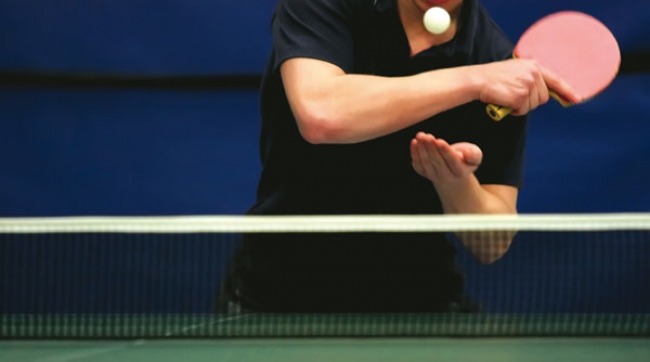
Backhand Chop Short Serve
Stand with both legs square with your body facing the table. Hold your left palm out flat with the ball in your palm. The right Ball arm should cross over on top of the left arm, so you can chop the ball away from your body in the serve so it hits the ball from underneath to give it the chop/backspin you need. Be still for a second before serving and then throw the ball about 6 inches in the air. Then strike the ball underneath gently hitting the ball long with backspin so it serves short on the other side of the court.
Bounce Goal with Backhand chop short serve: long bounce your side and short on their side.
This gives the ball slow speed and backspin. Again, once you get confident at this serve you can serve across the court or down the line to mix the serves up a bit.
Backhand Topspin Serve
Stand with both legs square with your body facing the table. Hold your left palm out flat with the ball in your palm. Very similar to the Backhand chop service, but this time, we want to drop your wrist and flick the ball upwards, so it give it that topspin you need. The right Ball arm should cross over on top of the left arm, with your wrist dropped. Be still for a second before serving and then throw the ball about 6 inches in the air, Then strike the ball over the top of the ball gently hitting the ball long with topspin so it serves in the middle of your court and long on the other side of the court.
Bounce Goal with Backhand topspin serve: long /middle bounce your side and long on their side.
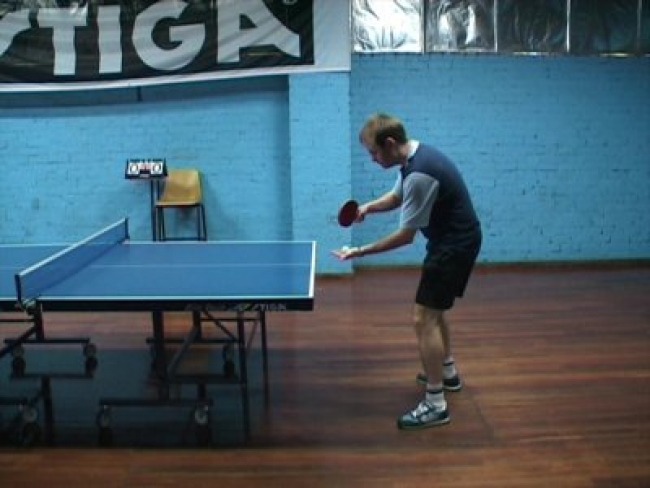
This gives it a good speed and topspin. This seems like a complicated serve but once you get the hang of it, it’s a very effective serve and will give you great enjoyment in the game. The key is to drop your wrist and flick the ball upwards to give the ball the top spin. Again you can serve across the court or down the line. (straight line torwards your opponent)
OK, have fun and take your time learning these serves, they do take a few weeks of practise to get the basics right, but once you get the hang of it, you'll be on fire and people will want to know "where you picked up these skills" and start to copy you!
Observing The Pro Masters Serve
Watching professional table tennis players is an excellent way to learn and improve your serve. Here are some pro players that you can watch to learn from:
- Ma Long - a Chinese table tennis player who is considered one of the greatest players of all time. He is known for his consistent and powerful serves.
- Timo Boll - a German player who has been ranked as high as number 1 in the world. He has a unique serving style that is both deceptive and effective.
- Xu Xin - another Chinese player known for his powerful serves and quick footwork. He is considered one of the most talented players in the world.
- Dimitrij Ovtcharov - a German player who has a powerful and consistent serve. He is known for his aggressive playing style and quick reflexes.
- Jun Mizutani - a Japanese player who is known for his creative and unique serving style. He is known for using a variety of spin and speed to confuse his opponents.
By watching these pro players, you can learn from their techniques, strategies, and styles to improve your own serve.
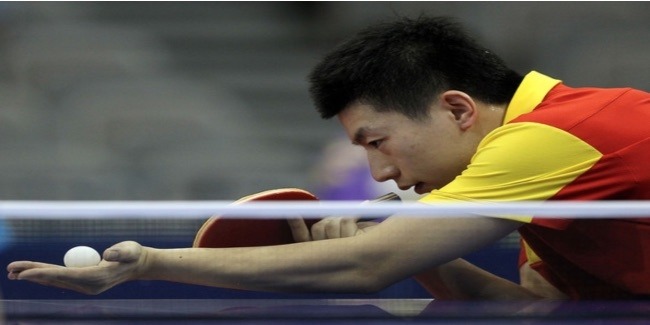
Table Tennis Serves Frequently Asked Questions (FAQ’s)
Serving in table tennis is an art that combines precision, technique, and strategy. As a beginner or even an advanced player, you may have questions about the rules, techniques, and best practices for serving. In this section, we address some of the most frequently asked questions to help you master the serve and elevate your game. Whether you’re curious about legalities, positioning, or execution, these answers will provide clarity and guidance.
Q1: Can I hide the ball with my body during the serve?
A: No, the ball must not be hidden from the opponent during the serve. This means that you cannot use your body or any other object to obscure the ball from your opponent’s view.
Q2: Can I touch the table with my free hand during the serve?
A: No, the server must not touch the table with their free hand or any part of their body during the serve. This rule ensures that the serve is executed fairly and without any unfair advantages.
Q3: What happens if I fail to execute a legal serve?
A: If you fail to execute a legal serve, your opponent will be awarded a point. It is essential to follow the rules of a legal serve to avoid losing points and to maintain the integrity of the game.
Q4: Can I serve the ball from any position behind the end line of the table?
A: Yes, you can serve the ball from any position behind the end line of the table. However, it is recommended that you find a comfortable and consistent position to serve from to improve your accuracy and consistency.
Q5: Can I use any part of my racket to strike the ball during the serve?
A: No, you must use the rubber surface of your racket to strike the ball during the serve. Using any other part of the racket can result in a lost point.
We hope these answers have cleared up any questions you may have had about legal table tennis serves. If you have any further questions, please feel free to reach out to us.
Ping Pong Coaching Videos
Since we aim to help everyone improve their table tennis game, we have produced a series of original ping pong teaching videos with Eli Baraty. Eli is a top coach from the UK and currently works with the Harefield Academy. We have coaching videos for all different types of serves and you can find them by clicking on the Youtube logo at the bottom of this page.
Chop Chop, get practising!
I hope you enjoyed this article on how to do a table tennis serve. Why not browse our lists of the best ping pong tables on the market and get a table to play on at home?
How To Do A Serve In Ping Pong - Coaching Video
Ellie from Table Tennis Center provides advanced serving tips for table tennis in a YouTube video. She recommends using side spin services as they can confuse opponents. Ellie’s favorite is the pendulum service, where you hit the ball sideways with your wrist and forearm, and can vary the placement of the ball. She also recommends using the opposite side spin service where you hit the ball from right to left. By mastering these serves, players can gain an advantage and win points.
Video Transcription
(00:01) i'm ellie from table tennis center and today i'm going to
give you some advanced tips for serving in table tennis or serving in
ping pong so in ping pong we have wide variety of services my favorite
are the services with a side spin because usually that confuses people
the most so the one i like in particular is uh this side spin service
where you hit the ball and allow the ball like you're hitting it
sideways from side to side here and it looks like this we also call it
pendulum service so the key points in this service you want to
(00:41) use your wrist right to add some extra spin and then forearm to
do the whole motion right here so pay attention that you really try to
spin the ball while your racket touches the ball and maximize the wrist
power at this point okay also this service you can do a variety of
placements you can go either cross court which looks like this or you
can do the down the line which is going to look like that so different
types of place placement but you're trying to brush the ball right here
okay and that’s how we're going to do
(01:27) the sidespin on this surface the other one i really like is the
opposite side spin that’s when you actually hit the ball the opposite
from right to left right here and it’s gonna look like that this way
okay again and try to use more wrist as you touch the ball okay so those
side spin services usually confuse people the most so i would recommend
you get a good size pin service and you might get a few points in each
set
Table Tennis : Advanced Table Tennis Serving Tips
Featured Articles
Dive into in-depth stories, exclusive interviews, and expert advice from the world of table tennis. Discover strategies, player spotlights, and behind-the-scenes insights.
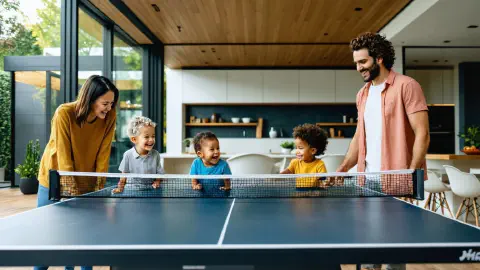
Ping Pong Revolution: How Table Tennis Transforms Homes, Offices, and Communities
Table tennis is uniquely positioned as one of the most versatile recreational activities available today. This comprehensive article explores the transformative impact of ping pong across three …
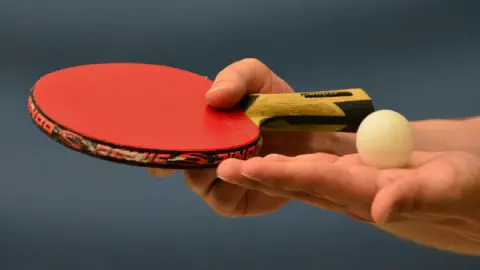
Basic Equipment Needed to Play Table Tennis
What is the basic equipment that you need to get started with playing ping pong? Our guide to the very basic table tennis equipment required to go ahead and start to play. A guide to the basics of …
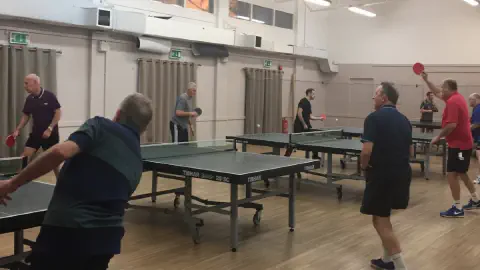
Is Ping Pong Good Exercise? The Top Health Benefits Explained
Table tennis is great exercise both for mind and body. You can use ping pong to keep fit alongside other exercise programs and raise your overall activity levels to lose weight and keep your mind …

Ping Pong Revolution: How Table Tennis Transforms Homes, Offices, and Communities
Table tennis is uniquely positioned as one of the most versatile recreational activities …

Basic Equipment Needed to Play Table Tennis
What is the basic equipment that you need to get started with playing ping pong? Our guide …

Is Ping Pong Good Exercise? The Top Health Benefits Explained
Table tennis is great exercise both for mind and body. You can use ping pong to keep fit …
